
17 government inspectors, 170 companies and more than 9,000 potential infractions: inside B.C.’s oversight of the oil and gas sector
Notes made by regulator officers during thousands of inspections that were marked in compliance with...
It’s a familiar sight: on a street in Winnipeg’s Lindenwoods neighbourhood, city workers shovel tarry, black asphalt into a small crater in the road while a third crew member perches atop a steamroller, ready to compact the fresh filling and seal the pothole off.
In a matter of minutes the crew will move on to another pothole, then another still. In less than an hour they’ll move to a new street and start again. The handful of holes the crew will tackle in this neighbourhood are some of more than nearly a quarter of a million city crews have filled this year — with thousands still remaining — after spring storms resulted in record deterioration of city streets.
In late April, Manitoba Public Insurance, the Crown corporation in charge of vehicle claims, sounded the alarm: it was already looking like a monumental year for pothole damage. Typically, the corporation sees an average of around 359 pothole damage claims per year. This year, they had nearly 500 claims by the end of March, and over 2,000 claims by June, the corporation says.
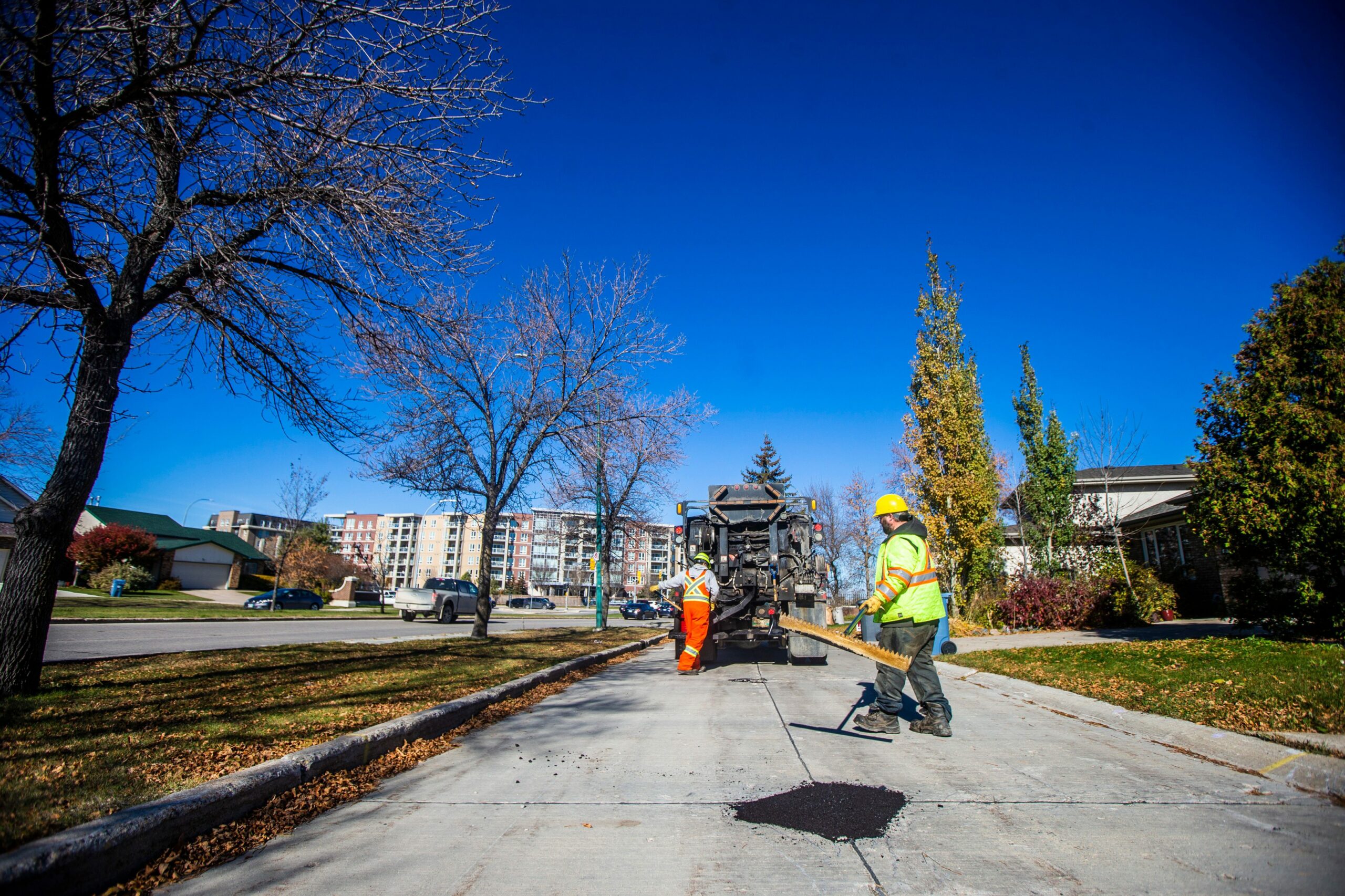
As every city motorist knows, Winnipeg has long had a pothole problem — drivers routinely veer and swerve to avoid slamming into the multitude of craters dotting city streets. Some potholes were so deep this year they revealed the long-forgotten streetcar tracks buried beneath the concrete. And the problem is only going to get worse. Wetter, harsher, warmer weather is predicted to pummel the Prairies as climate change intensifies across Canada, and those conditions present unique, chronic challenges for the city’s slate of old roads.
And Winnipeg isn’t alone. Extreme heat and torrential rain have caused pavements to disintegrate across the globe. This past summer, the United Kingdom was hit with a sweltering heat wave that wreaked havoc on its critical infrastructure. As the mercury hit 40 C, rail lines went up in flames and pavement on key roads buckled. Bloomberg News reported the same situation across the United States, Australia, China and Africa, as temperatures in a changing climate began to exceed the limits of decades-old infrastructure. Under the pressure of extreme heat, the roads expanded until they snapped or, in other cases, simply melted.
Closer to home, last year’s torrential November storms washed out whole sections of highway through interior B.C., trapping motorists and forcing evacuations as an atmospheric river swallowed several kilometres of road.
Researchers are busy finding new ways to strengthen the pavement against the growing impacts of climate change — Winnipeg has begun exploring new approaches to road construction and repair, acknowledging climate change is impacting the city’s roads — but the pace of progress is slow and the solutions are expensive. Local governments like Winnipeg’s are facing a challenge: how to protect and repair vulnerable roads before they run out of money — and time.
Michael Cantor is the man in charge of maintaining Winnipeg’s streets. Since 2018, he’s led a team of between 250 and 500 city workers as they patch potholes, clear snow and sweep streets and sidewalks. He knows Winnipeg is no stranger to pockmarked roads, but this year was “a peak one,” he says. The 211,500-plus potholes Cantor’s crews have already filled this year mark a more than 50 per cent increase over the yearly averages since 2018.
The problem, Cantor says, was that it was a really wet year. First, there was near-record snowfall through the winter, then the city was pummeled by a series of cold, rainy storms through April and May. All that moisture amounted to a more than 220 per cent increase in precipitation compared to historic averages — and that’s bad news for roads.
The mechanism of a pothole is fairly simple: during the wet months, moisture finds its way through cracks in the surface of the road and settles into any gaps it can find. When the weather cools, the water freezes and expands, forcing bulges and pockets in the road materials. When it gets warm again and the water melts, those bulges become cracks or holes in the pavement.
The freeze-thaw cycle makes roads most vulnerable in the spring and fall, when temperatures hover around the freezing point for a few weeks. Extreme summer heat can put pressure on roads, too. Pavement normally swells in the heat, but can crack and buckle if it expands beyond its limits.
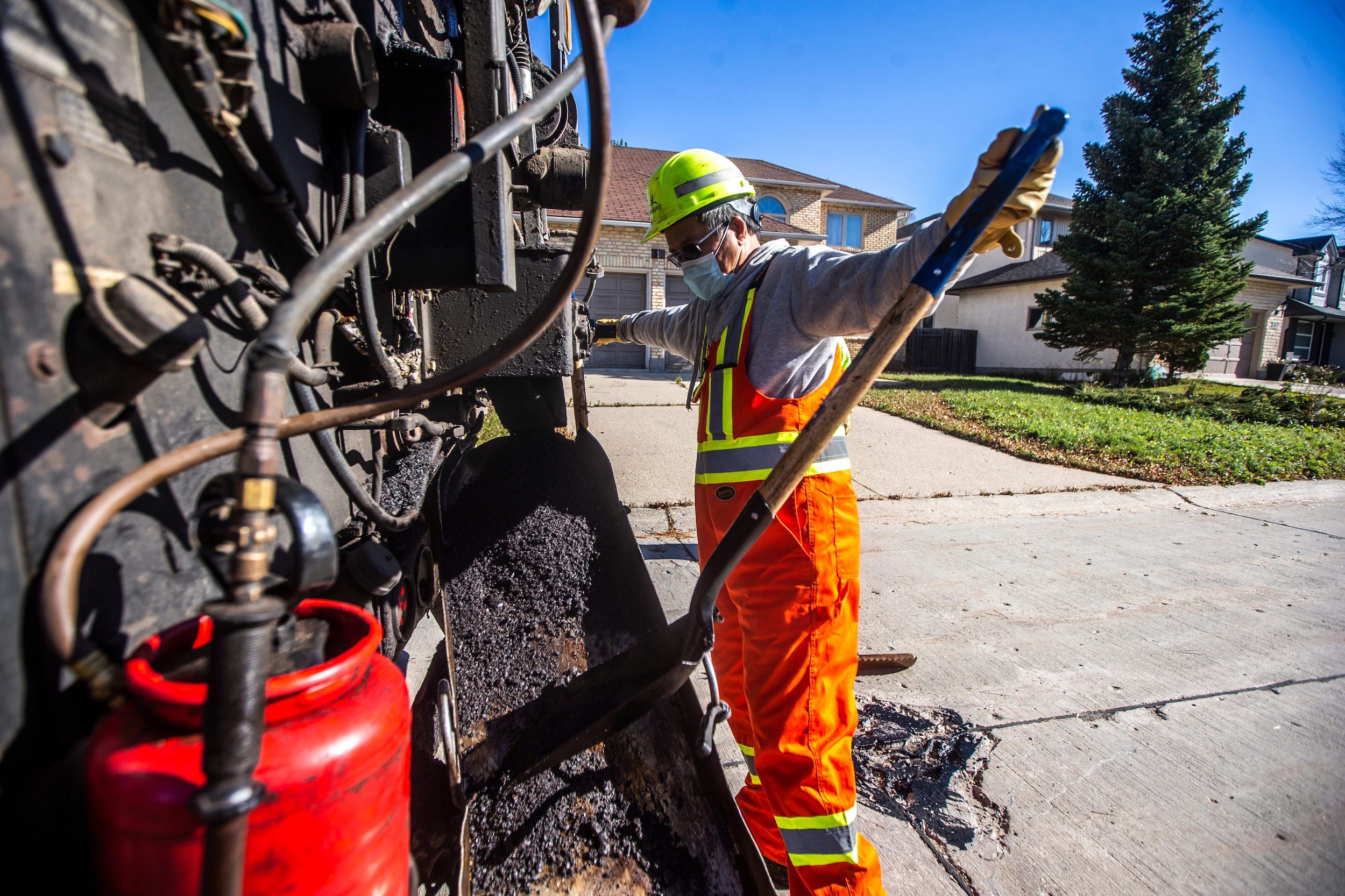
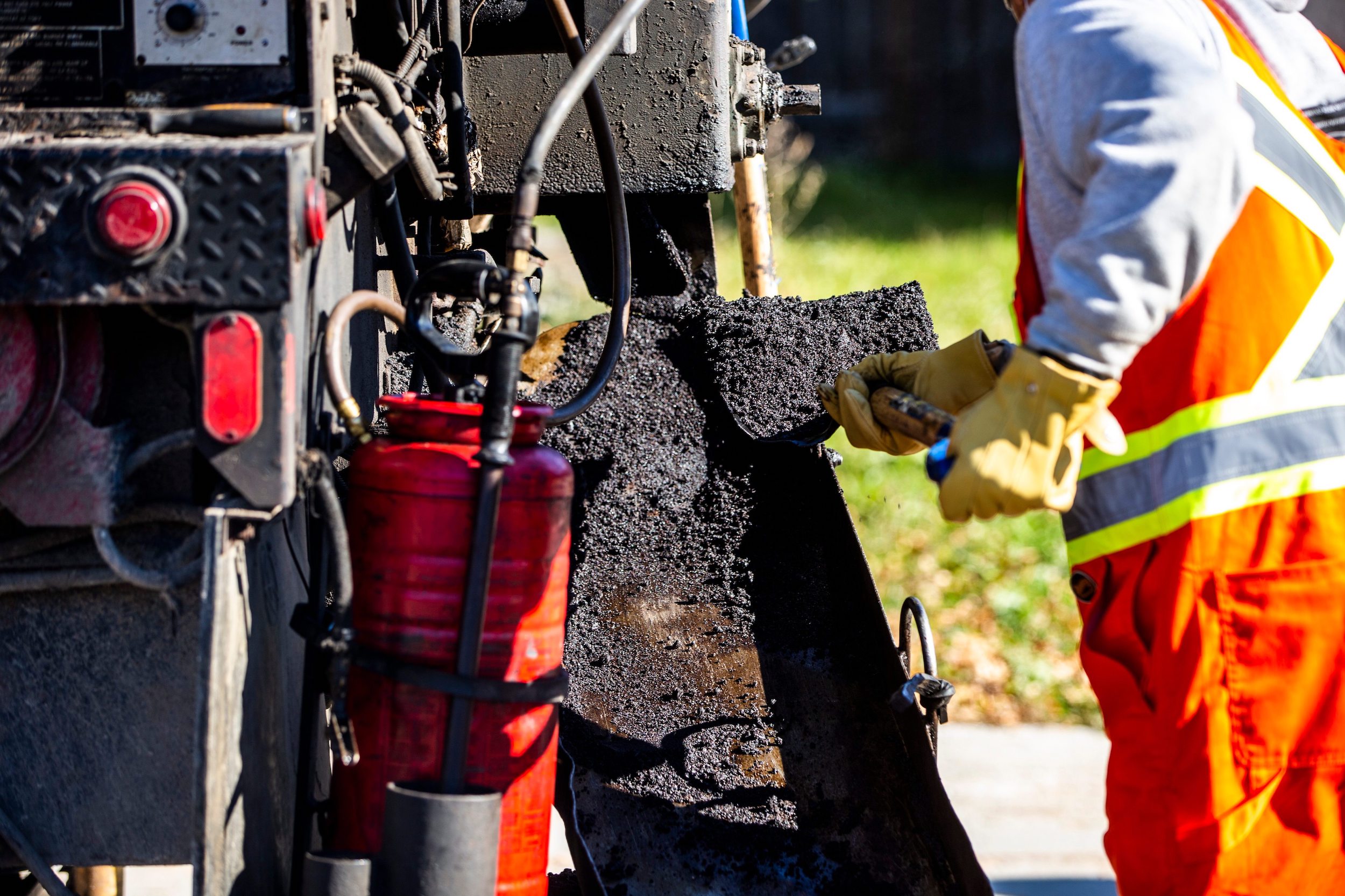

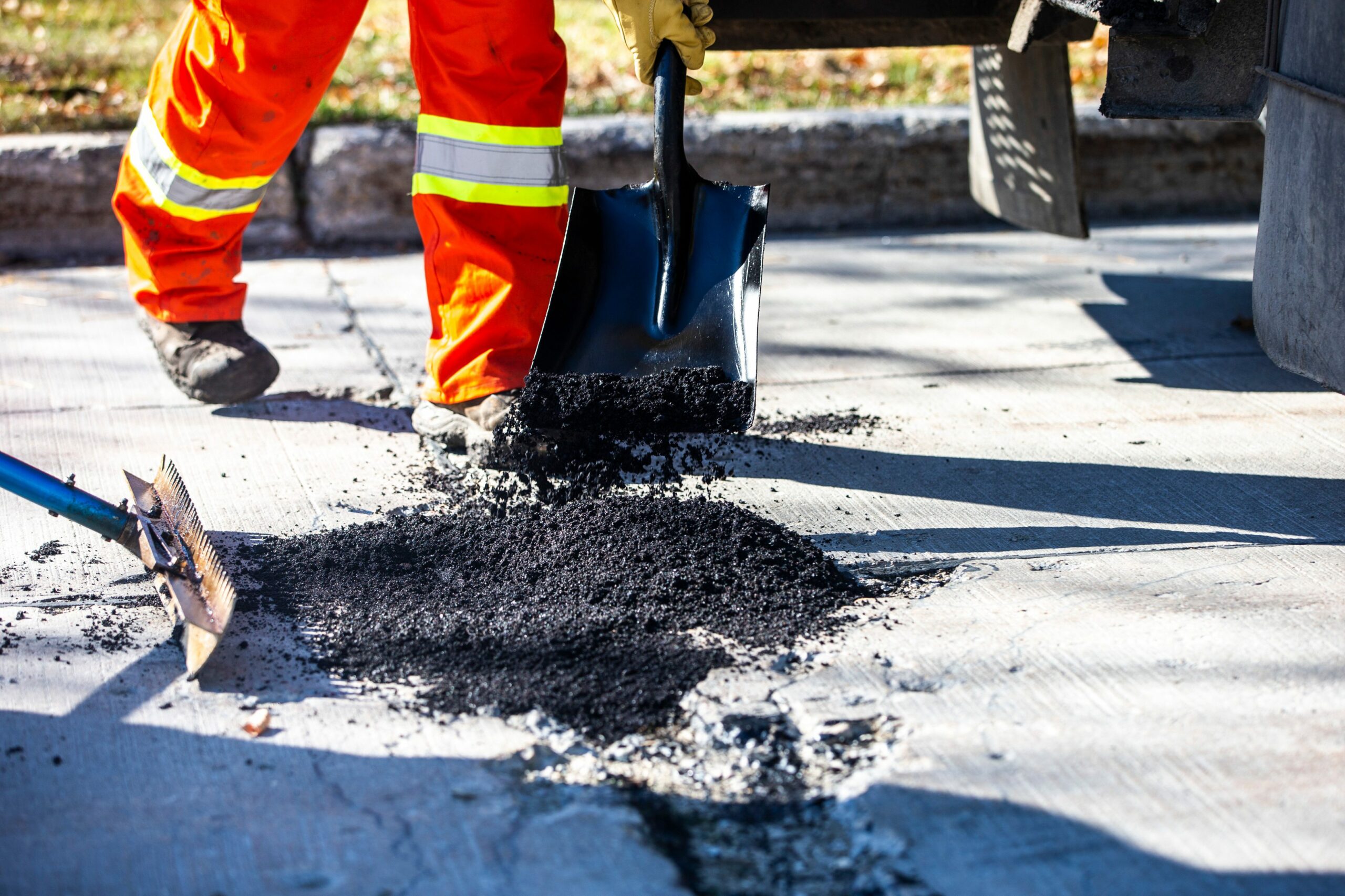
While it only takes maintenance teams a few minutes to pour and compact the asphalt, the work is never-ending. Cantor says his teams work year-round to patch the most dangerous potholes, but they can’t get to every one, every year. They start with the most serious ones — large potholes on high-traffic streets — then prioritize calls by severity and location. So far this year, the city has received more than 13,000 calls to 311 for pothole-related issues. They’ve closed at least three-quarters of those calls, and will keep working, weather permitting, until November. But there are always more potholes to fill than the crews can get to in a given year.
Experts agree the Prairies are set to see more hot days and rainy springs in the coming years, and Cantor’s work shows no signs of slowing down.
With a municipal election just days away, Winnipeg’s mayoral candidates have made no shortage of promises about the roads. Some have promised to increase the budget line for repairs; many have pledged a system that repairs broken roads before funding new ones; others have expressed a commitment to working with researchers to develop new materials better able to withstand climate impacts. After all, potholes are a nuisance at best and a danger at worst — and they’re plain expensive, too. A 2021 CAA study found the average Canadian driver spends an extra $126 on their car per year thanks to poor road conditions.
But while Winnipeg’s pothole problem is frustrating and expensive for residents, it’s symptomatic of a challenge that extends beyond the bounds of city hall: Canada’s roads are old, they’re deteriorating faster than ever and there isn’t enough money to fix them.
When Winnipeg last released its assessment in a 2018 state of the infrastructure report, the city’s 7,335 kilometres of road were, on average, 48 years old. At the time, 60 per cent were considered to be in good or very good condition, earning an overall “fair” quality rating, but they’re reaching the end of their useful life. Most roads are built to last 50 years or less, though properly timed maintenance can help extend their lifespan to about 70 years — in the best of conditions. (The city scored marginally better in a 2020 road assessment, which found approximately 70 per cent of roads in good condition, however this report also indicated 67 per cent of roads in good condition in 2018.)
The 2019 Canadian infrastructure report card, penned by a conglomerate of engineering, construction, transit and public works associations, says about 80 per cent of the country’s roads and highways are in the latter half of their lifespan. More concerning, they say: about 16 per cent of the country’s roads — some 146,000 kilometres — are in poor or very poor condition. That’s enough, the report says, to build a highway halfway to the moon.
“The state of our infrastructure is at risk,” the report warns in its opening lines.
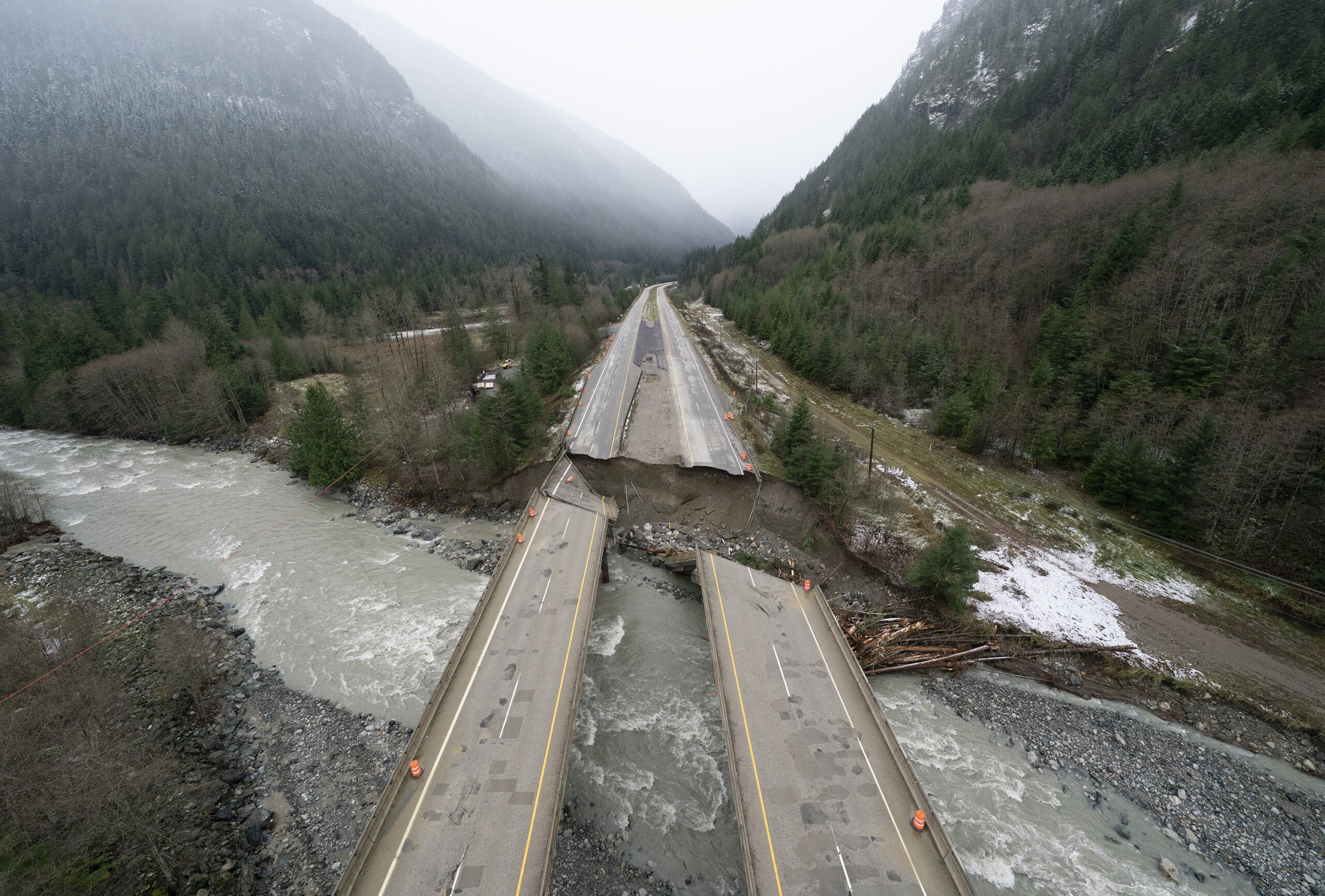
A 2016 Natural Resources Canada report on climate risks and adaptation opportunities for the country’s transportation sector has projected what a warming climate could mean for roads in the future. The Prairies have already seen about a 1.5 C temperature increase since 1948 and an increase in late spring rain — patterns that are expected to intensify without significant intervention and a reduction in carbon pollution.
The report makes clear these shifting climate and weather patterns will have an impact on the country’s transportation networks. More rain means more flooding, erosion and landslides; more frequent freeze-thaw cycles are predicted to contribute to more rapid road deterioration; extreme heat in the summer is expected to cause more rutting and oozing on asphalt roads — and these are just the chronic problems. A changing climate is also expected to bring unpredictable disasters like fires, tornadoes, hurricanes and floods, all of which can cause acute destruction to roads.
As the impacts of climate change continue to put pressure on infrastructure, road repair stands to get more costly. A recent report from the Canadian Climate Institute estimates Canadian governments will need to spend about 20 per cent more per year on road repair and maintenance owing to climate-related damages — with $3.1 billion added to the bill each year. Ontario’s financial accountability office recently crunched the numbers on climate change and infrastructure, finding the toll of heavy rain and hot summer days could increase the province’s infrastructure maintenance costs by an average 13 per cent — that’s $1.5 billion — every year this decade.
This leaves municipalities with few options: repair roads reactively, working to keep up with the rising pace of deterioration, or build roads proactively, using more resilient — albeit expensive — materials to prevent the costs of future damages. Both approaches require significant financial resources, but experts suggest a proactive approach can reduce net climate-related costs by up to 84 per cent in the long run. Canada’s infrastructure report card suggests each dollar spent preserving roads up front can save at least six dollars in repair costs down the line.
According to Winnipeg’s engineering manager Brad Neirinck, pothole fills fall into the “reactive” category.
“At the end of the day, pothole repairs are kind of like short-term safety and repair measures: they’re not meant to be a permanent fix,” he says.
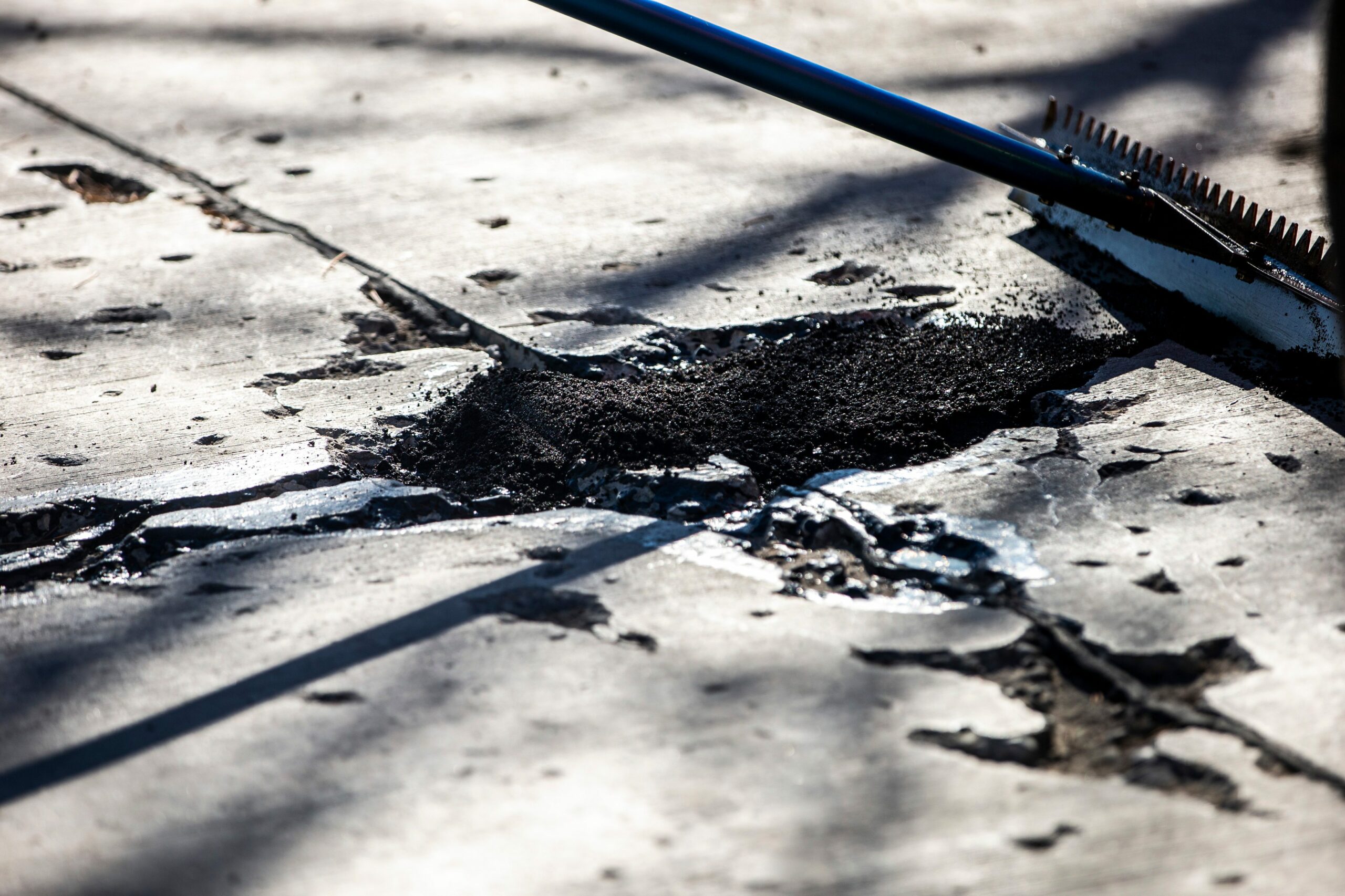
Filling potholes is a necessity — the cracks are hazardous to road users — but it’s also a cheap fix. The repairs cost, on average, $17 per hole and can last anywhere from a few months for winter potholes to a few years for potholes filled and paved in the warmer seasons, according to the city. Something meant to be a little more long-lasting, like a “mill and fill,” a relatively minor maintenance procedure that shaves off a layer of road to repair and replace the asphalt, costs approximately $400,000 per kilometre. Major road reconstructions can cost millions.
Winnipeg has been tackling its aging roads head on. The city’s approved 2022 budget included a “highest-ever” budget for road renewals at $164.7 million — by far the largest chunk of the city’s capital budget. This came on the heels of a “highest-ever” budget line for roads in 2021, which itself exceeded the “highest-ever” road budget in 2020.
But even without accounting for the increased economic impacts of climate change (neither Winnipeg or Manitoba have modeled the financial risks associated with a warming climate as of yet), the city would struggle to afford a more proactive approach to repairs. A quick crunch of the numbers reveals this year’s record spending is only enough to replace less than one per cent of the city’s roads per year. In other words, Winnipeg can only afford to replace each kilometre of road once every hundred years.
Ahmed Shalaby, a professor of civil engineering and head of the University of Manitoba’s pavement research team, is in the business of future-telling. Leaning on more than three decades of experience in civil engineering, Shalaby leads a team of researchers who are trying to design roads that can withstand the conditions to come — without breaking the bank.
The walls of his lab are lined with shelf upon shelf of road cores of varying shapes and sizes, each with a particular blend of rock, sand, recycled materials, asphalt and cement.
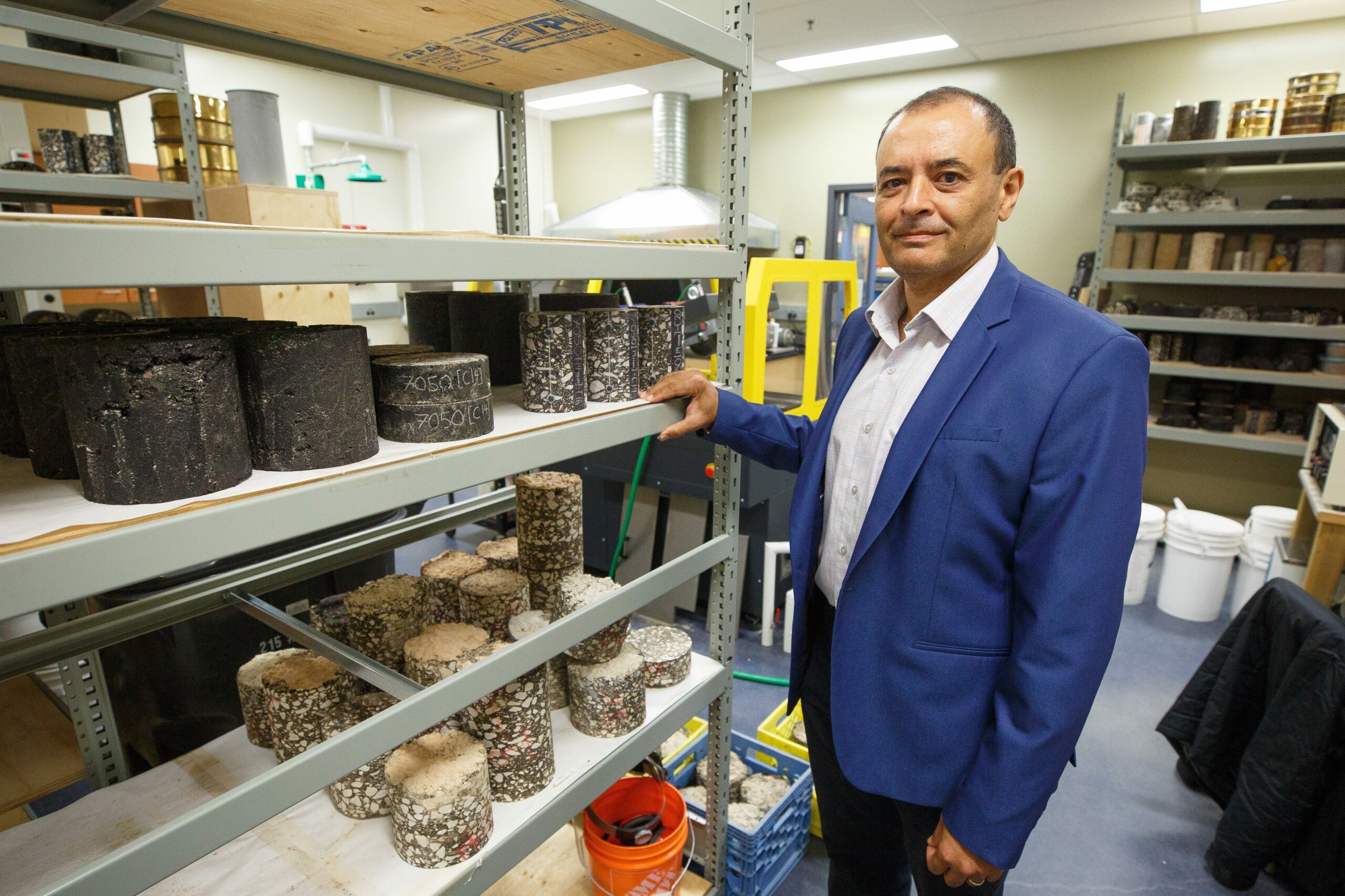
Those samples represent attempts at a new approach to road design. Winnipeg’s roads are either concrete, asphalt or some combination of the two. Both involve mixing different material like crushed rocks, shredded roof shingles or tiny chunks of plastic — with a binding agent. Concrete roads use cement, while asphalt roads use a sticky, black, crude-oil byproduct called asphalt cement, or “oil,” as the engineers say.
In the lab, each sample is tested to see how that particular recipe might hold up against heavy traffic, fluctuating temperatures, increased moisture and the decay of time, using machines that can quickly mimic the impacts of several decades of road use.
“We basically look into the future,” Shalaby says. “And based on that assessment decide how to tweak these materials and get more out of them.”
Thanks to that experience, Shalaby wasn’t surprised by this year’s crumbling pavement. He knew the spring storms wouldn’t be easy on the roads — but he was surprised by just how powerful those storms were. Historically, Winnipeg averages 30 millimetres of precipitation in April and 57 millimetres in May. This year, the city got almost 120 millimetres in April and more than 160 millimetres in May.
“This was very unusual, even for us, to experience a kind of weather where the roads were taken to one extreme, in terms of amount of precipitation, then another extreme, very cold,” Shalaby says. “It was like a one-two punch.”
The engineers who designed Winnipeg’s roads decades ago would have relied on years of historic weather data to inform their material choices and composition, but nobody thought to design for wild swings like the 220 per cent increase in rainfall this spring, Shalaby says, adding the designs were meant to be cost-effective, not to hold up against unforeseen extremes.

Nowadays, researchers like Shalaby are working with better tools. Instead of leaning on decades of past weather in their design plans, they work with software that can predict the weather patterns to come.
“I think if you ask anyone in this industry today, they have a good understanding of the impact of climate change,” Shalaby says. “We don’t have a great understanding of how to react to that, how to account for climate change yet, but we’re moving in the right direction — slowly.”
Engineers at the City of Winnipeg, for example, are working hard to adjust the materials at all levels of the road; from changes to the sediments in the base layers beneath the surface, which they hope will improve water drainage, to the density of the concrete in the surface layers, which they hope will provide more resilience against the freeze-thaw cycles — which have quadrupled in the last decade, according to city engineers — to changing the oil content used in asphalt mix to make it more resilient in extreme heat and less susceptible to rutting.
But even a small change in policy or engineering specifications can take years to implement. Road construction is a vast industry, and “it’s very difficult to turn that ship on a dime,” Shalaby says. Not to mention, Shalaby stresses, local governments are hampered by the limitations of their budgets: “Sometimes life-cycle costs are not as important to them as initial costs.”
According to Matt Gemmel, director of policy and research at the Federation of Canadian Municipalities, that funding challenge exists coast to coast.
“Municipalities own about 60 per cent of the infrastructure in the country, so it’s a big risk, a big liability, for municipalities,” Gemmel says.
Though federal and provincial governments will often chip in funds for the upfront costs of infrastructure projects, operating and maintenance costs fall squarely on local municipalities, even though these governments have just a fraction of the revenue at their disposal. As the costs associated with climate change grow, cities are left with few options to grow their budgets accordingly.
“You’re really left with charging residents more for the things that they use — water or garbage or transit — or increasing property taxes,” Gemmel says.
While Canadian cities had, on average, doubled property taxes between 1998 and 2016, Winnipeg had only raised taxes nine per cent, according to the city’s 2018 infrastructure report. In recent years, the city has raised property taxes at a rate of approximately 2.3 per cent annually, though Winnipeg still collects less in municipal property taxes compared to other Canadian cities. That approach has left the city grappling with what it calls “an unsustainable level of debt,” including a $2-billion deficit for road work.
But that deficit is not unique to Winnipeg either — the national infrastructure deficit is estimated to fall between $110 billion and $270 billion, according to a Federation of Canadian Municipalities report, and decades of funding cuts have produced a backlog of maintenance projects nationwide.
Experts agree sustainable infrastructure capable of adapting to climate challenges will require long-term, consistent funding. Canada has one federal program aimed at this goal: the Canada Community-Building Fund (formerly known as the Gas Tax Fund) allocates an annual sum of over $2 billion to municipalities on a per capita basis, to be spent on infrastructure-related expenses as local governments choose.
“That’s a really valuable source of revenue for cities and communities of all sizes, because it’s predictable, they can count on it, and it’s quite flexible what they can spend it on,” Gemmel says.
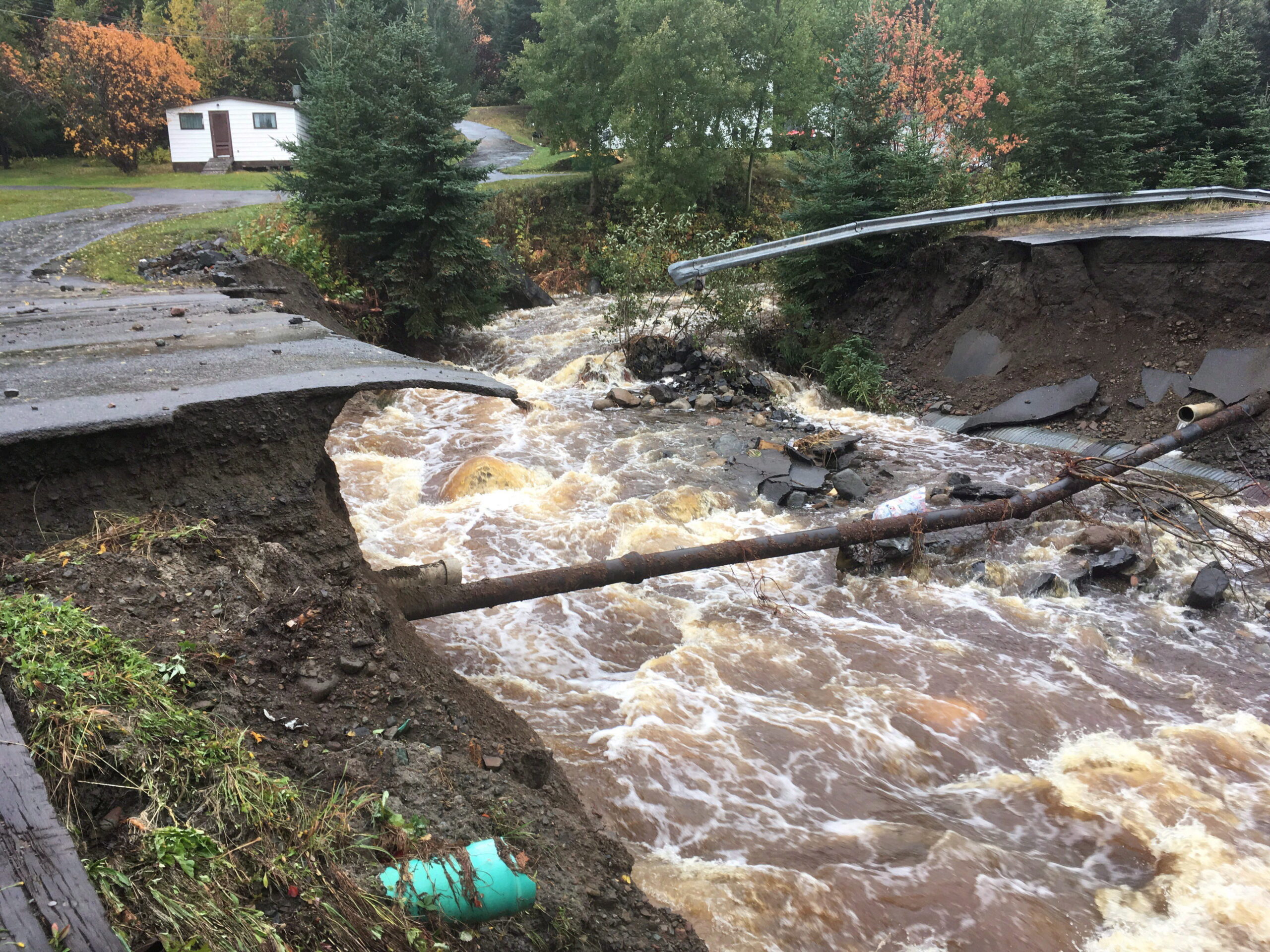
The federation is currently lobbying the federal government to permanently double the fund — as they did in 2019 and 2021 — while also increasing its annual growth from two per cent to 3.5 per cent.
“With climate change you need to look long term, you need to understand how climate is going to impact your infrastructure assets and you need to budget for the long term,” Gemmel says.
“You can’t fix all the potholes next construction season, you can’t strengthen all your water infrastructure against the impacts of flooding in one year — it’s something that takes time.”
It’s time that worries Shalaby most. Road deterioration has a snowball effect — if left untreated at the end of the construction season, it’s only going to get worse come next spring. That snowball effect is only going to get more intense under more extreme climate conditions, but it’s unclear how quickly things will intensify.
Shalaby sees hope in the fact that new technologies are already being developed and implemented to better assess road conditions, predict new weather patterns and apply that learning to long-term asset management. Winnipeg started using future climate models in its road designs in 2019. There are new technologies aimed at automating quality checks and gathering more rapid, consistent data from roads.
Still, “the changes in climate have been extremely aggressive,” Shalaby says. “You never know if you’re running out of time.”
Get the inside scoop on The Narwhal’s environment and climate reporting by signing up for our free newsletter. On March 17, federal Conservative Leader Pierre Poilievre...
Continue reading
Notes made by regulator officers during thousands of inspections that were marked in compliance with...

Racing against time, dwindling habitat and warming waters, scientists are trying to give this little-known...

From investigative reporting to stunning photography, we’ve been recognized with four 2024 CAJ Awards nods...
